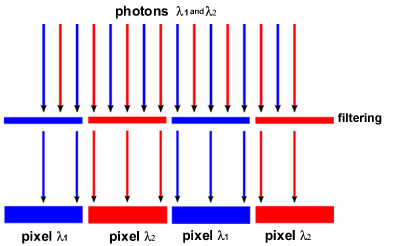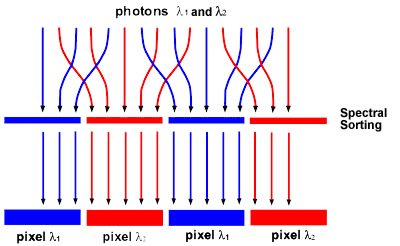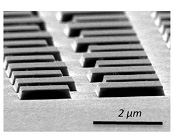After creating the smallest cryogenic infrared camera in the world in late 2011, research engineers at ONERA reveal another world first: the sorting of photons by their wavelength, at a micrometric scale.
This system revolutionizes the usual trade-offs between sensitivity and full color inherent to standard filtering, since this sorting technique allows all of the incident photons to be retrieved and used, while filtering "loses" photons. In practice, sorting is performed by nano-antennas located on the same surface, which allows pixel miniaturization at the wavelength scale to be considered. Its performance is unrivaled in terms of sensitivity and resolution.

Spectral filtering principle: filters only let one color through (or wavelength); with 2 colors 50% of the radiation is lost.

Spectral sorting principle: nano-antennas have a funneling effect on the photon flux and capture 100% of the radiation corresponding to their wavelength, which they transmit to the corresponding pixel: sensitivity twice as high as that achieved with a simple spectral filtering like that shown in the previous figure (two colors).
The first demonstrations of this principle were performed in ONERA’s Onda laboratory (opto-electronic nanomaterials and related devices), from joint work with the Dota (ONERA’s Department of Theoretical and Applied Optics) and the CNRS/LPN (Laboratory of Photonics and Nanostructures). The research was supported with funding from the ANR and ONERA: the Carnot Antares and the Intrepid project. Charlie Koechlin and Patrick Bouchon’s theses greatly contributed to these results.
This work is planned to continue by making a technology demonstrator, a discriminating vision camera providing information about the "infrared color" and therefore about the nature of the materials or gases observed. Such a camera may be of interest for defense or for environmental monitoring (detection of pollutants, for example).
Meet a prototype by 2014!
![]()

On the left, view of square pixels, each consisting of four square nano-antennas.
On the right, side views, nano-antennas sized to select the infrared wavelengths of de 7.58, 8.17, 8.9 and 9.47 µm.




